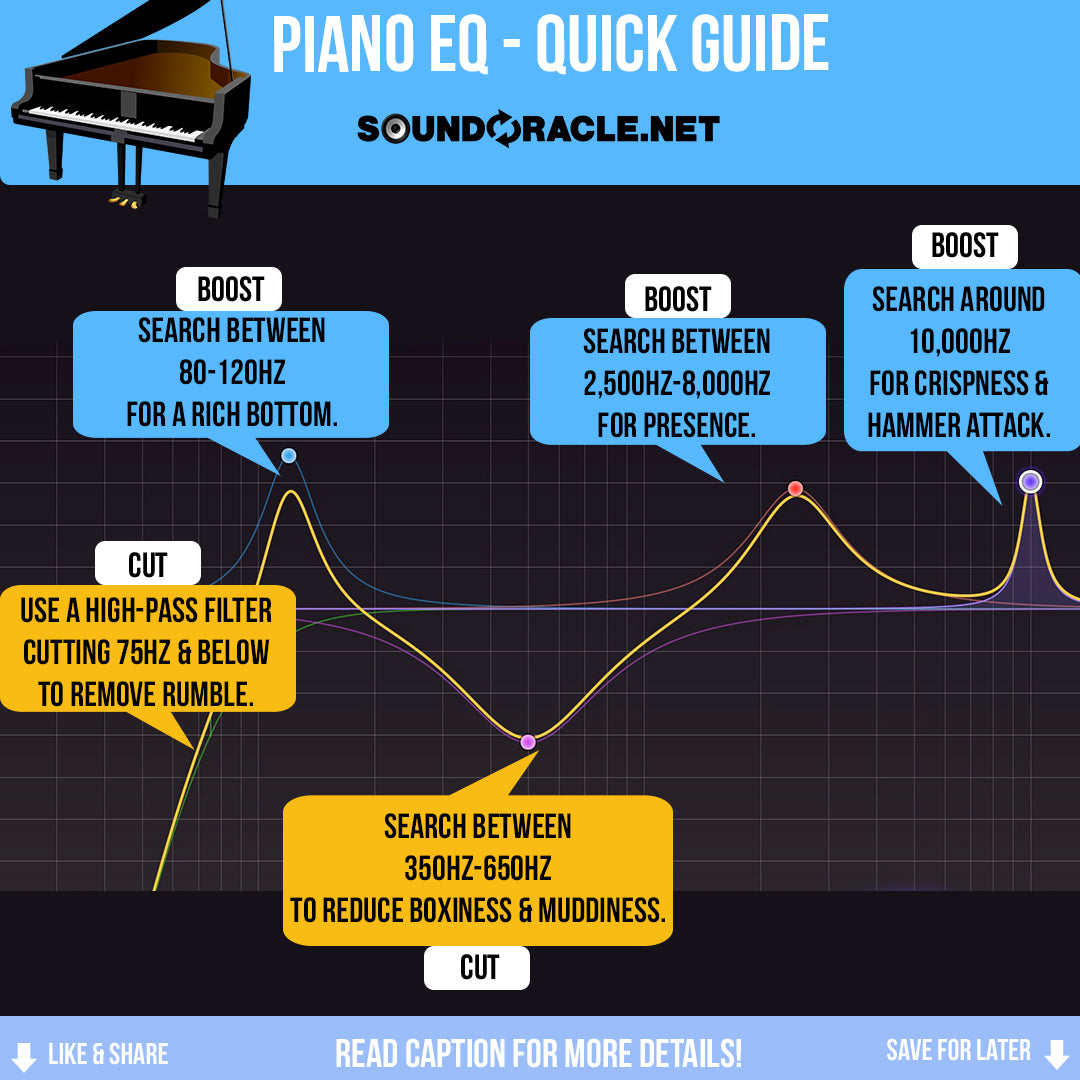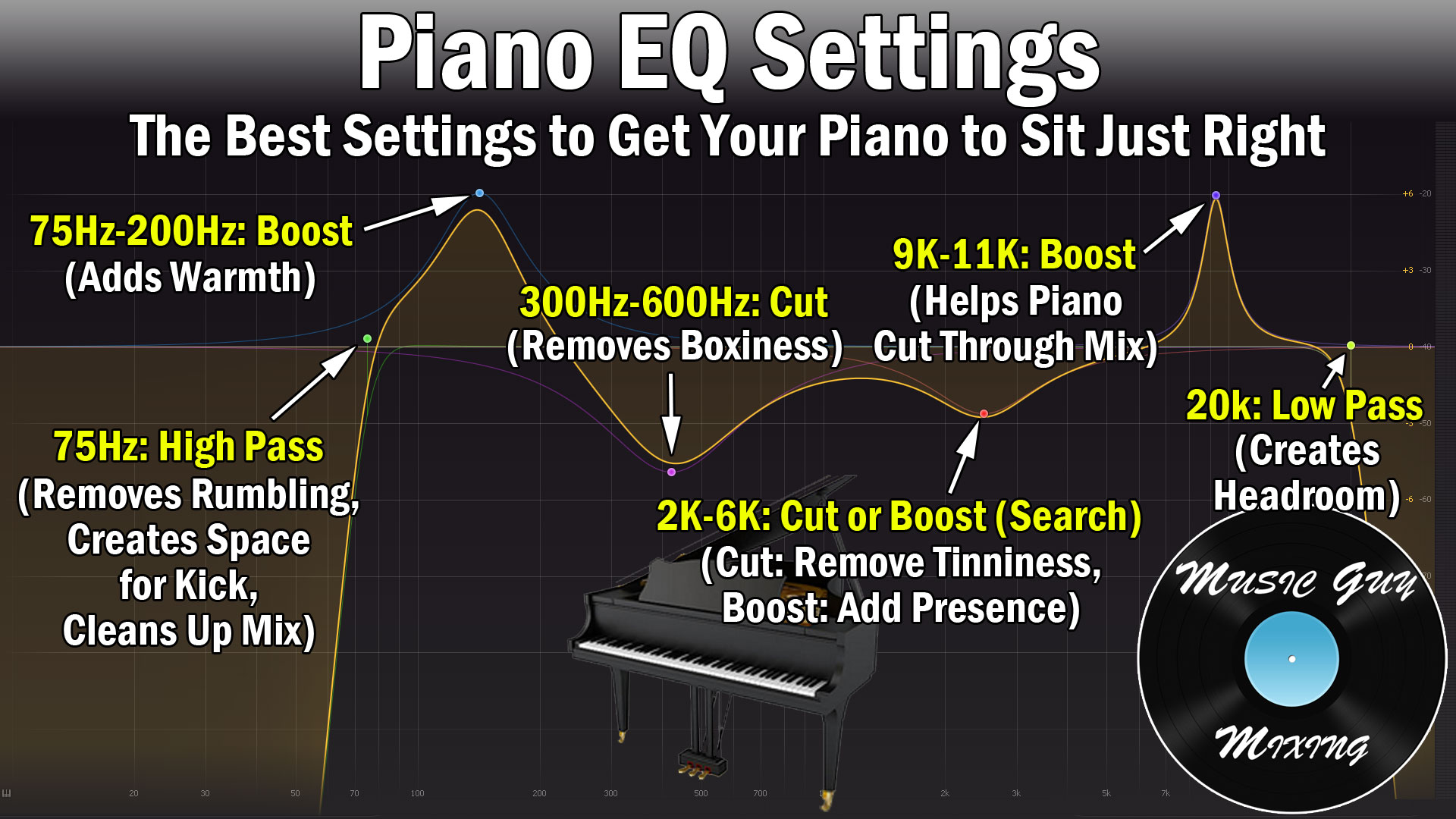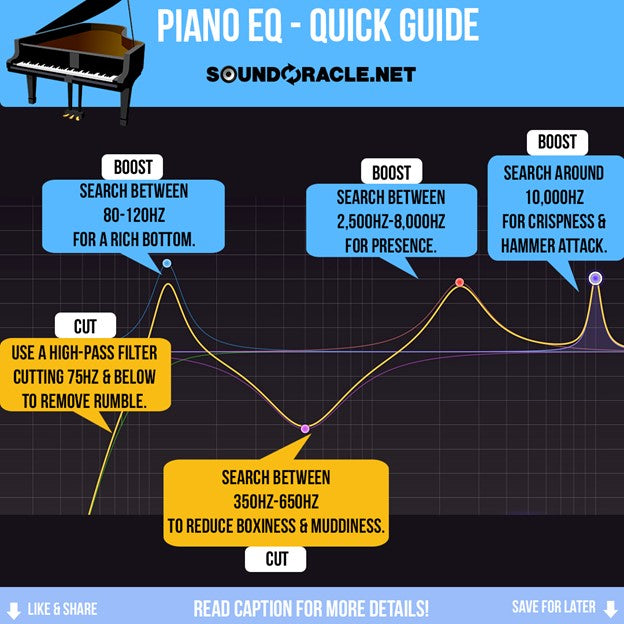Piano EQ is the process of adjusting the sound frequencies of a piano to achieve a desired tonal balance. Piano EQ enhances the tonal character of a piano and produces a more harmonious listening experience.
A well-tuned piano is essential for music creation, and the process of Piano EQ helps to ensure that every note played on the piano sounds great. Piano EQ involves adjusting frequencies to change the piano’s tonal balance and improve sound quality.
The process is often performed by professional sound engineers or experienced piano technicians with a trained ear. With the right adjustments, Piano EQ can help produce balanced and dimensional sound that is both pleasing and inspiring to listeners. The method is especially appreciated by classical music lovers who are attuned to precise and nuanced sounds.
Anatomy Of Piano Eq
Piano EQ involves adjusting frequency levels to enhance clarity, warmth, or brightness of the sound. It’s important to understand the different elements of the piano, such as the overtones, attack, and sustain, to create an ideal sound.
Eq Frequency Spectrum
The equalization of a piano is essential to get the desired tone and character. The frequency range for a piano spans from 27.5 Hz (A0 on the lowest keys) to 4186 Hz (C8 keys on the highest). Generally, the piano’s sound is divided into three main frequency regions: bass, midrange, and treble. Each region has its own distinctive character and provides the piano with its unique voice. EQ adjustments are made to balance the piano’s frequency spectrum to suit different musical genres and playing styles.
Understanding Octaves
Octaves are a fundamental concept in piano sound design, formed by doubling or halving a tone’s frequency. The note you play and its octave is what creates the piano’s tone. The piano has eight full octaves plus a few additional notes. Each note is usually played with at least three strings, making it’s octave sound fuller and thicker. You can use EQ to control and balance the different frequencies of each note and octave and adjust them according to the desired sound.
Filters
Filters are essential tools used in piano EQ to reduce or boost the piano’s frequency spectrum. Low-pass filters are mainly used for the bass frequencies, cutting out any high frequencies that may muddy the sound. High-pass filters are applied to the treble regions to reduce low-frequency rumble and improve clarity. Bell filters are excellent for fine-tuning the midrange, while shelving filters are used for adjusting the highs or lows of the entire frequency range. By using filters, you can shape the sound of the piano and achieve your desired tone with precision. In conclusion, EQ is a powerful tool that can transform your piano’s sound and give it life and character. By understanding the anatomy of piano EQ, the frequency spectrum, octaves, and filters, you can easily adjust your piano’s EQ to suit your specific needs and make it shine.

Credit: soundoracle.net
How To Eq A Piano
Equalizing a piano can be a challenging task but it is critical to create a balanced and professional sound. EQing can help remove any unwanted frequency buildup and enhance the overall tone of the piano. In this article, we will discuss the steps involved in EQing a piano sound.
Preparing The Piano Recording
Before you start EQing, you need to ensure that your piano recording is of the highest quality. Make sure you have captured the sound of the piano correctly so that you can work with it easily during the EQ process.
Here are some tips to help you prepare the piano recording:
- Use a high-quality microphone to capture the sound of the piano.
- Make sure the piano is in tune before recording.
- Avoid any external noises that may interfere with the recording process.
Basic Eqing Techniques
After you have recorded the piano, you need to apply some basic EQing techniques to balance the sound. Here are the steps you can follow:
- Start with a Flat EQ – Start by applying a flat EQ, which means no frequencies are boosted or cut. This gives you a clear baseline to work with.
- Identify problem frequencies – Use your ears to identify any problem frequencies that need to be removed, such as muddy or harsh sounds.
- Cut unwanted frequencies – Use a narrow band cut to remove the problem frequencies. Be careful not to cut too much, as this can affect the natural sound of the piano.
- Boost frequencies – After cutting unwanted frequencies, identify areas that need to be boosted, such as the high or low frequencies. A slight boost can add warmth and depth to the sound of the piano.
Advanced Eq Techniques
If you want to take your EQing to the next level, you can use advanced EQ techniques such as:
| Technique | Description |
|---|---|
| Multi-band EQing | Allows you to work on specific frequency bands to enhance or reduce them as needed. |
| Dynamic EQing | Increases or decreases gain automatically, depending on the level of input signal. |
| Multiband Compression | Combines both compression and EQing to enhance specific frequency bands and control dynamic range. |
Eqing In A Mix
Once you have EQed your piano sound, you can move on to EQing it in a mix. Here are some tips to help you achieve a balanced mix:
- Make sure the piano sits well in the mix and doesn’t clash with other elements.
- Use ear training to identify frequency conflicts with other instruments.
- Don’t over-process the sound – a subtle EQ can go a long way.
Common Piano Eq Problems And Solutions
When it comes to piano sound, a great EQ mix is essential. Equalization plays a critical role in tone shaping and allows you to solve several common piano sound issues. Here are some of the most challenging piano EQ problems and solutions:
Muddy Sound
A common issue with acoustic pianos is that they can sound muddy. Muddy sound is characterized by a lack of clarity and definition in the low frequencies. To address this issue, you will want to cut some low frequencies on your EQ. This will help to give the piano a clearer sound. Try reducing the low frequencies below 200 Hz.
Harsh Sound
The opposite of a muddy sound is a harsh sound. A harsh piano sound has a lot of high frequencies and can be unpleasant to listen to. You can reduce harsh sounds by cutting high frequencies on your EQ. Try reducing the high frequencies above 4 kHz.
Uneven Frequencies
Uneven frequencies are a common issue with acoustic pianos. When you play certain notes, they may sound louder or softer than others. To solve this issue, you will need to identify which frequencies are causing the unevenness. Once you have identified the problematic frequencies, you can use EQ to adjust them. Try boosting or cutting specific frequencies to balance out the sound.
Dull Sound
A dull sound is characterized by a lack of brightness. Dull sounds can be caused by too much low or mid-frequency content. To brighten up a dull piano sound, try boosting the high frequencies on your EQ. Start by boosting the high frequencies above 2 kHz.
Boxy Sound
A boxy sound is characterized by an overly resonant mid-range. This can make the piano sound like it is boxed in. To fix this issue, you will need to cut some mid-range frequencies on your EQ. Try reducing the mid-range frequencies between 500 Hz and 1 kHz.

Credit: www.musicguymixing.com
Eqing For Different Piano Genres
Having good EQ settings is essential when it comes to different piano genres. Classical piano requires more warmth and punch, jazz piano benefits from a brighter, more focused sound, while pop piano needs a balanced EQ with a little bit of sparkle.
Eqing can help your piano tracks sit well in the mix and stand out in the right way.
If you’re an audio engineer, music producer, or a pianist, you know that each piano genre has its unique sound. And, as a content writer, I know how important it is to have a strategy for EQing when it comes to different piano genres. In this blog post, I’ll discuss different EQ settings for each of the following piano genres: Classical Piano, Jazz Piano, Pop Piano, Rock Piano, and Electronic Piano.
Classical Piano
Classical piano mainly focuses on sustain, dynamics, and harmonics. To achieve that, you can give a little boost around 1kHz to enhance the presence, and keep the low end light by cutting at around 200Hz. A slight boost around 3kHz can bring out the brightness in the piano, making it sound more expressive. However, there’s no hard and fast rule, you can always adjust the frequencies according to your liking.
Jazz Piano
Jazz music is all about groove, timing, and expression. EQing jazz piano requires a little bit of warmth and presence. To achieve that, you can give a little boost to the lower frequencies around 100-200Hz. Cutting around 400Hz can remove unwanted boxiness that muddies the sound. To add some shine, you can boost around 2-5kHz and cut around 8kHz as it can reduce the harshness in the sound.
Pop Piano
Pop music has a bright, punchy, and radio-friendly sound. To achieve this, you want to make the piano sound more prominent. To do so, you can boost around 1-2kHz, it enhances the piano’s clarity and brings it to the foreground. For warmth, you can add some boost around 200Hz. Cutting around 500Hz can remove the muddiness from the mid-range.
Rock Piano
Rock piano is all about powerful chords that fill the space and leave an impact. EQing for rock piano can be aggressive, boosting around 2kHz can bring out the presence and clarity in the piano. Cutting around 500Hz can remove the muddiness and make the sound cleaner. Adding a little boost around 100Hz can make it sound heavy.
Electronic Piano
Electronic pianos are used in a variety of genres, from hip-hop to pop and electronic music. For an electronic piano, you can add some warmth and fullness by boosting around 200Hz, that will give it a ‘phat’ sound. Boosting around 800-1kHz can make the sound more present and snappy. For a futuristic sound, you can take out the mid-range by cutting around 500Hz. To wrap up, EQing for different piano genres can be challenging, as each genre has its unique characteristics. Applying these EQ techniques can enhance the overall sound of your music, making it more polished, expressive, and professional.

Credit: soundoracle.net
Frequently Asked Questions Of Piano Eq
How Do You Do Eq On A Piano?
EQ on a piano can be done by adjusting the levels of various frequency bands. Use an equalizer to change the tone by increasing or decreasing specific frequencies. It can be helpful to listen to different instruments or recordings to get a better idea of what changes to make.
What Does Eq Mean In Piano?
EQ in piano stands for “equalization,” which refers to the ability to adjust the balance of frequencies in your sound output. It can be used to reduce unwanted sounds or to enhance the sound of the piano in a particular room or environment.
What Is The Best Frequency For Piano?
The best frequency for a piano is A 440 Hz, which is the standard pitch used in most modern music. However, some pianos may have a slightly different pitch depending on their age or tuning. It’s essential to keep your piano tuned regularly to achieve the best sound quality.
How Do You Mix Piano Sounds?
To mix piano sounds, follow these steps: 1. Ensure the levels are balanced. 2. Add EQ to enhance the sound. 3. Utilize compression to even out varying loudness. 4. Experiment with reverb and delay for ambiance. 5. Consider panning for spatial positioning.
Conclusion
Understanding the basics of piano EQ is essential for achieving a clear and balanced sound. By identifying and adjusting key frequencies, pianists can enhance the character and tone of their instrument. It’s also important to remember that EQ should be used sparingly and in conjunction with other techniques, such as proper microphone placement and playing technique, to achieve the best possible results.
Overall, mastering piano EQ can greatly improve the quality of a recording or live performance and is a valuable skill for any musician to have in their toolkit.